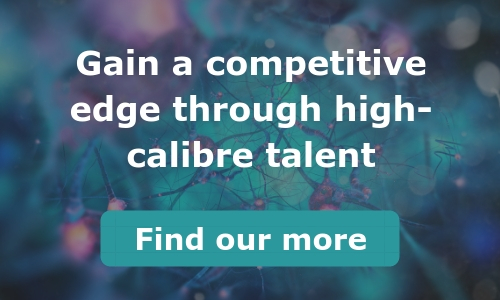Being smart will get you far in the life sciences, and the hiring process is no exception. SMART goals allow you to hire effectively, remain an attractive prospect even in a competitive job market, and retain the A-performers that can take your life science organisation to the next level.
As a hiring manager in the life sciences, you’re less concerned about hiring metrics. (Though it’s good to know the basics. Check out our article: 8 Hiring Metrics To Focus On In Your Life Science Recruitment Strategy). Instead, it’s job and culture fit that are top of your mind.
Put simply; you want to ensure you hire the best candidate for the job and provide everything they need to ensure they can hit the ground running. Trouble is, you can’t expect your new hires to excel in the role if you, the hiring team or the applicant aren’t sure what success looks like.
By setting SMART goals and defining expectations ahead of the hiring process, you give your new senior-level hire the best possible chance of success.
SMART hiring goals
First introduced in 1981, SMART is an approach that works across multiple disciplines. It stands for:
S – Specific. Define your hiring goals and objectives. Start with the mission – its core purpose – and work backwards.
M – Measurable. Key performance indicators allow hiring managers to access the performance of new hires.
A – Achievable. Effective goals are challenging yet attainable. A-level hires are driven by achievement, and clear goals give them a roadmap for success.
R – Realistic. Have realistic expectations for the position. Outline key deliverables your new hire will need to accomplish within 3, 6 and 12 months.
T – Timely. Create realistic time frames for hiring and onboarding new candidates and ensure the process are in place to reduce time to hire.
Hiring goals are essential to accomplishing business objectives. When you hire a new senior manager or executive, they will:
- Have an understanding of what is expected of them
- Have a way to measure their progress and success
- Have a time frame to accomplish their goals
Hiring goals have the additional benefit of creating a transformative relationship between employee and organisation. Compensation is transactional by nature and paid to employees on the proviso that they complete set tasks and achieve their goals. Once brought into an organisations goals and mission, an employees performance is typically much more impactful.
Likewise, hiring managers can better support business-critical objectives with SMART hiring goals as they are better able to communicate their expectations clearly and avoid costly hiring mistakes, for example, the new candidate turning out to be a poor fit for the role. Setting SMART hiring goals helps ensure both the new hire and the hiring organisation are on the same page.
Hirings impact on achieving organisational goals
Hiring strategies have a measurable impact on organisational goals. One SMART strategy is the implementation of policies that support workplace diversity, inclusion and employer brand.
The importance of diversity and inclusion
Studies have shown that increasing workplace diversity has a direct effect on the bottom line. Specifically, those organisations with diverse management teams have 19% higher revenue. In this respect, employee diversity is more than a laudable metric. Diversity puts different minds and ideas together, which can result in innovative approaches and a stronger, more optimised output.
Think about it for a moment. We all have different tastes, preferences and ideas which impact our decision making. Diversity means diversity of minds. The more diverse the minds involved in decision making, the more due diligence performed on every new idea, thus making the solution stronger, well rounded and optimised. That can be the difference between success or failure.
In a sector as competitive and innovative as the life sciences, can you afford not to place diversity and inclusion at the top of your agenda when hiring business-critical roles? Revisit your job specification, job adverts and career pages to ensure you’re painting your life science organisation in the best possible life from a diversity and inclusion perspective.
Promoting the employer brand
Employer branding is “the process of promoting a company, or an organisation, as the employer of choice to a desired target group…” (Universum, 2014). It is the identity of the organisation in the eye of the applicant and extends far deeper than how you position your life science organisation on your career pages or social media. It extends to your employees too.
Every new hire has the potential to strengthen employer brand. After all, your employees are your brand ambassadors; that’s why websites like Glass Door have become so popular. When your hire with cultural fit in mind, an important organisational goal is achieved. Your hiring process is geared up to finding, shortlisting and onboarding applicants who complement company culture.
An important point: promoting employer brand starts on the job specification and career pages and extends throughout the interview process to the offer of engagement. When hiring goals and expectations are made clear from the outset, it paints a positive image of the organisation to prospective employees. You’ll improve employee satisfaction and, by extension, retention.
RELATED: Increase quality-of-hire by partnering with a reputable talent consultancy
Hirings impact on achieving function-level goals
The right hiring process makes it possible to attain function-level goals. Every senior-level management or executive role in life science requires specific expertise, skills and qualifications. When you define these prerequisites clearly as part of your SMART hiring goals, the result is transparency, not only for the applicant but across the organisation too.
Hiring the best applicant for the position is central to the success of any life sciences organisation. They supply the skills and expertise needed to advance their team or department and increase its productivity. Poor hiring decisions, even for mid-manager level roles, can cost your department budget dearly; approximately three times a senior manager or executives annual salary.
However, make the right hiring decisions and the benefits compound themselves. Providing your onboarding process doesn’t leave your leadership-level candidates languishing, you can have them up-to-speed and productive in a matter of months. Which in turn means they can start delivering on the goals and objectives you outlined for them early on in the hiring process.
Align competencies with business goals
“Competencies are abilities or attributes, described in terms of behaviours, key to effector and/or highly effective performance within a particular job” (University of Nottingham, 2018)
According to research by Brandon Hall Group, nearly two-thirds of companies lack a competency programme or are still in the process of defining competencies for business-critical positions. The study stressed the importance of placing and aligning competencies with business goals. Those that do are 67% more likely to rate their competency objectives as effective.
When a life sciences company invests in and produce competencies that align with their business objectives, it establishes the maturity and effectiveness of its competency development and management practice. Research indicates that the maturity level dictates its impact on important business indicators in addition to other talent management strategies. For example:
- Increased revenue.
- Greater customer retention.
- Improved customer satisfaction.
So when hiring for business-critical senior management and executive positions, ensure your define key competencies as part of setting SMART hiring goals. Be sure these core competencies are reflected in the job spec and job advert. Then, during the shortlist and interview process, ensure you prioritise these key competencies when accessing candidates’ fit for the role.
Attracting and retaining talent
Hiring goals play a crucial role in attracting and retaining top talent. This is because:
- A-players relish the opportunity to take charge and help others. If the job spec doesn’t suggest that the role involves goal achievement, it’s unlikely to attract high-achievers.
- A-players think strategically. Goals that emphasise long-term objectives appeal more to high-achievers than job specs that merely list the high-level responsibilities of the role
- A-players want to be perceived as subject matter experts. If you indicate that industry expertise is a prerequisite for the position, you will get more high-achievers applying.
- A-players see challenges as opportunities instead of obstacles. If the position offers goals that are challenging yet attainable, it’s more likely to attract A-players.
These hiring goals must feed into your executive onboarding process – the process by which you transform a successful applicant into a loyal and productive employee. How you implement these goals during the onboarding process can make the difference between a new hire leaving within six months or choosing to develop their career at your life sciences organisation.
The hiring process is square one in building a relationship with potential new employees, so it needs to contribute to overall organisational goals. When you craft job specifications that attract top talent, the positive impact is felt on multiple levels: organisational, functional, and business. When your strategy attracts A-lister, you’re investing in your life science organisations’ future.
For more hiring advice tailored to hiring managers in the life science industry…
- Read 8 Hiring Metrics To Focus On In Your Life Science Recruitment Strategy.
- View our talent solutions to see how we can help you gain a competitive edge through talent.
* Fraser Dove International is a talent consultancy operating exclusively across the life sciences industry. While our roots lie in executive search, we provide more than the traditional recruitment services. Uniquely placed within the market, we have been providing cutting-edge talent solutions and insight to organisations at all stages of their journey – from start-up to established leaders – since 2013.

 Estimated read time: 6 mins
Estimated read time: 6 mins Date posted:04/02/2019
Date posted:04/02/2019





